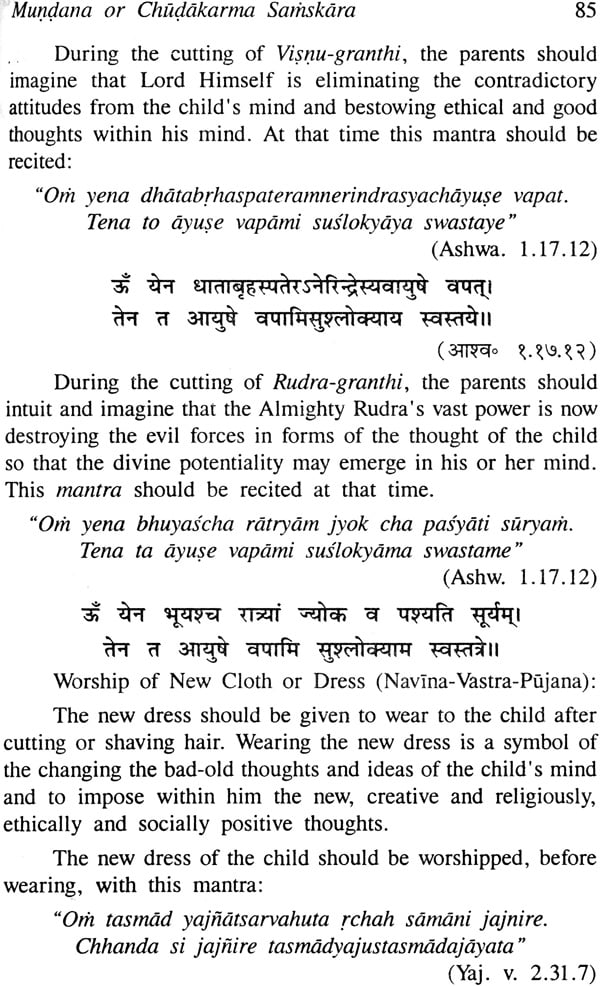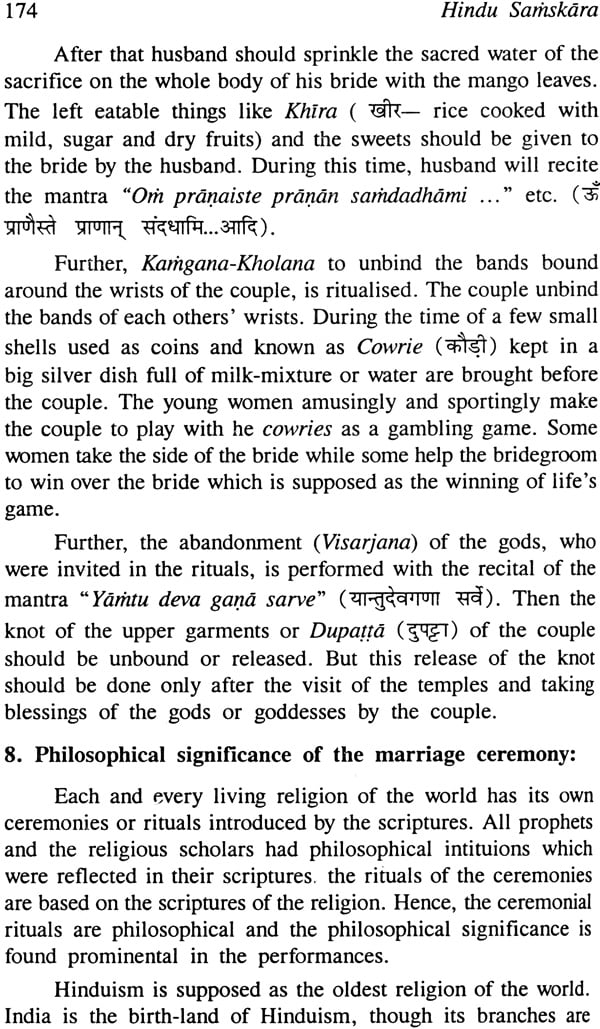
Hindu Samskara (An Old and Rare Book)
Book Specification
| Item Code: | NAK169 |
| Author: | Dr. Laksmi Sinha |
| Publisher: | Eastern Book Linkers |
| Edition: | 1999 |
| Pages: | 215 |
| Cover: | Hardcover |
| Other Details | 8.5 inch x 5.5 inch |
| Weight | 360 gm |
Book Description
Religion, with all its aspects (cognitive, affective and conative), emphasises the psychical as well as the physical discipline of an individual in society. Almost all the religions of the world, therefore, observe verieties of sacraments or Samskaras with a view to culture the infant's brain in supra-sensuous way. Hindu religion an oldest religion, which is manifested in the Vedas, the Puranas, the Brahmanas, the Grhyasutras, the Smrities etc., has emphasised the importance f fthe sacraments or ceremonies or the Samskaras from the period of the emergence of the child in mother's womb till death.
Therefore, the Hindu religion has introduced the Samskaras, varying in number, but eminently accepted in sixteen number. In this book only few Samskaras have been described, as in modern age, only these Samskara are generally observed in Hindu society. Hindus, living in India or abroad, believe in the ethical and spiritual values of the Samskaras and perform these ceremonies during the occasion with full faith and devotion. These ideas are expressed in this book.
Dr. Lakshmi sinha Professor of Philosophy (Rtd.), B.R.A. Bihar University, M.D.D.M. College, Muzaffarpur.
A female author joined as a lecturer in 1961 in a degree college and retired as a University Professor in 1996.
Her articles are published in daily newspaper of Bihar and J&K and other literary magazines. Her First book "Humanistic Trenda in Indian Ethics" was published in 1986. Second Book Hindu Samskara (in English) Third book Dharam Barshan (in Hindi).
Hinduism, an oldest living religion, is an organised accumulation of the religious experiences of the perfect sages ascetics and mystics. It is a highly organised system which shows the way of life. Hindu religion, in its old traditional form, is known as 'Saniatana Dharma' or an eternal religion.
In Hindu religion, Samskara or Ceremony is an important media to develop and elevate the other as well as the inner qualities of human personality. It is said:-
"Samskaranam samyak karanam Va Samskarah" It means-Samskara is the generated outcome of the performances of ceremonies directed by the shastras in the form of karmakandas with an aim to elevate the personality. In Hindu religion, samskara is actually a spiritual treatment of Sixteen kinds (generally accepted by the Hindues), which beings from the womb ends after the death. In ancient India, each and ever individual was supposed as the manifestation of God in spiritual human form. From the very beginning of human civilization Hindu Samskara is an important source of social and religious unity. Other living religions of the world, alike Hindu religion specifically give importance to their own sacraments or samskara with an aim of socio – religious unity.
In the Vedas, Brahmans, Grhyasutras, Dharma – sutras and the sruties, we get the Vivid descriptions of the ceremonies but not in systematically arranged form. Even in modern period, this subject (samskara) is completely neglected by the scholars.
Here, it is my effort to show that during primitive phase, in tribal society, the conception of the ritual or ceremony was originally a religious belief. But gradually it converted into a social and cultural form.
Samskara or ceremony is a symbolic religious performance in which the bio-psychical discipline is established through the symbolic rituals. Therefore, to describe the underlying significance of the symbols ritualised in the processes of the samskara is very necessary so that it may be understood by the general people. I have tried my best to explain it.
The purpose of samskara is to generate the extra – ordinary human qualities so that the person can emerge as a heroic person who may develop the spiritual society of the world. In my book this purpose of samskara has been explained in short and précised from.
The historical development of the Hindu samskara (with its methods, karmakandas, ethical customs etc.) has been described here. From pragmatic point of view, this subject has been minimised and announced as useless for the materialistic progress but a few have got the intuitional insight behind the performances of the samskaras. In modern period we find the graceful impact of the rituals or the samskaras in ultra – modern families too, whether they are in India or living abroad. Those people who have got interest to know the Hindu culture and primitive life style in present days also, will definitely take interest in this subject. Hence, it is my effort in this book, to make them believe that the Hindu ceremonies originated in the psychological background are not mere superstitions but are relevant and adequately rationalised.
To follow the rules and regulations of any society, we have to culture our mental and physical behaviour with some norms and Hindu ceremony does the same. The Hindus believed in the social organisation from the very beginning of human civilization and therefore, these Hindu ceremonies were important from the very beginning of Hindu life. The ceremonies influence the society theoretically and practically both. The conception of duty as well as ideals comes in child mind from the very beginning of life and this is due to the environment effect of his family. In behaviour whatever a child does, show s his inherent cultured mental idea. In primitive culture the priests were authorised to cultivated the samskara in child's mind but in modern age state government and educational institutions do it.
The ritutals and ceremonies directly or indirectly influences the social organisation. From birth till death, there are so many rhythmical rituals for different occasions which inspire human feelings and co-relate life's ceremonial occasions with inspiring mystical influences. No person can overpower the omnipresent influence of the Rta which is supposed as the symbol of Truth and Necessity. The omnipotent rhythmical course of the Rta is a Truth and its denial will be a curse for and Hindu Samskara performances protect the sanctity of this feeling. This idea is projected in my book.
The ritual performing processes sometimes irritate the rational minds and they underestimate the underlying symbolic significance of samskara but it is their fault who donot have patience to introspect the truth of rituals.
This book is written by me with devotion and I pay my respect to the scholars who are the source of my inspiration. I respectfully dedicate my book to them.
This book, I hope, will inspire the educated people. The students and teachers of Mauritius will also like this book. University of Cambridge syllabus, (Introduced in Maurititues Hinduism Paper, Selection B) includes those Hindu rituals which are elaborately depicted in my book.
| Abreviations | iii | |
| Transliteration | iv | |
| Introduction | vi | |
| 1 | The Meaning and Number of Samskara | 1-22 |
| 2 | Samskara ke prayojana | 23-35 |
| 3 | Childhood Ceremony (Saivsana Samskara) Jata Karma Samskara (Birth Rituoal) | 36-46 |
| 4 | Namakarana Samskara | 47-68 |
| 5 | Anna Prasana Samskara | 69-78 |
| 6 | Mundane or Chudakarama Samskara | 79-86 |
| 7 | Saiksania Samskara (Educational Ceremony) | 87-119 |
| 8 | Vivaha Samskara | 120-175 |
| 9 | Antyesti Samskara | 176-201 |
| 10 | Conclusion | 202-203 |
| 11 | Bibliography | 204-211 |
| 12 | Index | 212-214 |








